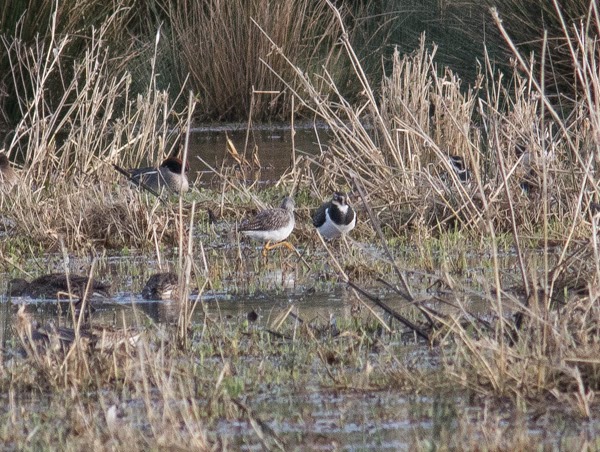Farlington Marshes
There was a bitterly cold north-westerly breeze, which I had expected but the occasional driving rain I had not, and it made for quite an unpleasant walk around the seawall at times. The tide was high when I arrived, and Dark-bellied Brent, Canada and a couple of Greylag Geese were feeding on the reserve. Duck species were represented in good numbers, with Pintail, Wigeon, Teal and Shelduck all present. The water on the main lake was quite high and as a result there was no wader roost to speak of, a few Redshank, a couple of Snipe and an Avocet was about it. Five Bearded Tits were giving great views whilst feeding in the reed bed right next to the sea wall, and a Reed Bunting perched up briefly before flying off.
 |
| Dark-bellied Brent Geese - Farlington Marshes |
There must have been well over a thousand brent geese on the marsh, with most of them on the middle marsh. I was scanning through them on the off chance of picking up a Black Brant, I did not find one but did pick up the colour ringed individual below. This is now the third colour ringed brent I have found in the last couple of weeks so will send them off soon to see where they are from.
 |
| Colour ringed Dark-bellied Brent Goose - Farlington Marshes |
As the tide was dropping, hundreds of waders were leaving their high tide roosts and starting to feed on the intertidal. The majority were Dunlin, but also Knot, Redshank, Bar-tailed Godwit and Grey Plovers. A flock of Black-tailed Godwits were roosting on the stream, two of which were colour ringed. Unfortunately, they were both roosting on one leg so I was unable to get a full combination. The stream is where the Spoonbill has been hanging out, but it was not there today.
 |
| Black-tailed Godwit - Farlington |
By the time I returned to the seawall the tide had dropped considerably. Waders were feeding all over the intertidal but the highlight was a flock of 47 Avocets, that were feeding in the Broom Channel to the west of the reserve.
Walpole Park, Gosport
My visit to Walpole Park was in the hope of ticking off the Ring-billed Gull for the year. I pulled up and immediately picked it up sat next to the lake. Well, I say lake, but work is currently being carried out on them so both lakes have been drained to leave just mud. Luckily this work hasn't deterred the ring-billed as it was sat in its usual place. I couldn't resist taking a few more pictures.
 |
| Ring-billed Gull - Walpole Park, Gosport |
 |
| Ring-billed Gull - Walpole Park, Gosport |
 |
| Ring-billed Gull - Walpole Park, Gosport |
Titchfield Haven
I didn't stop long at the Haven, just enough time to scan the exposed mud around the seafront and look up the valley for the Marsh Harrier. There was nothing really of note, a few Great-crested Grebes were on the sea, and Teal and Pochard on the river. A Buzzard was perched on a post by the south scrape, looking for an easy meal no doubt. A few hundred gulls were on the foreshore, at least 20 each Common and Herring Gulls, a couple of hundred Black-headed and one Mediterranean Gull.
Curbridge
When I got to Curbridge the tide was low and Little Egrets, Redshank and Greenshank were feeding in the creek by the Horse and Jockey pub. In the main estuary there were another three Greenshank, 11 Redshank and five Curlew. My main reason for going though was to check out the low tide gull roost, as you never know what might drop in. There was a good sized flock present, at least 250 birds, that was made up mainly of Black-headed Gulls, but there was also 67 Common Gulls, four Herring and three Mediterranean Gulls. I have been birding this creek since I was a teenager and had never previously recorded Med Gulls until last year when over 200 were present.. Three times this week I have visited and recorded at least one on each visit. One of the Meds was colour-ringed with a red ring, with white numbers, Unfortunately I could only make out the last two numbers, which were 99, before the whole flock was flushed by a Buzzard.
 |
| Common, Mediterranean and Black-headed Gulls - Curbridge |












































